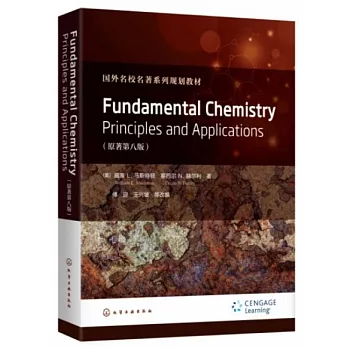1 Atoms 1
1-1 Atoms and the Atomic Theory 1
1-2 Components of the Atom 2
The Human Side: John Dalton 3
1-3 Quantitative Properties of the Atom 5
1-4 Introduction to the Periodic Table 11
Beyond The Classroom: Mastering the Peri’god’ic Table 14
Summary Problems 16
Questions and Problems 16
2 Electronic Structure and the Periodic Table 19
2-1 Light, Photon Energies, and Atomic Spectra 20
2-2 The Hydrogen Atom 25
2-3 Quantum Numbers 28
2-4 Atomic Orbitals; Shapes and Sizes 32
2-5 Electron Configurations in Atoms 33
The Human Side: Glenn Theodore Seaborg 37
2-6 Orbital Diagrams of Atoms 38
2-7 Electron Arrangements in Monatomic Ions 40
2-8 Periodic Trends in the Properties of Atoms 43
Beyond The Classroom: Why Do Lobsters Turn Red When Cooked 47
Summary Problems 49
Questions and Problems 49
3 Covalent Bonding 52
3-1 Lewis Structures; The Octet Rule 53
The Human Side: Gilbert Newton Lewis 62
3-2 Molecular Geometry 62
3-3 Polarity of Molecules 70
3-4 Atomic Orbitals; Hybridization 73
Beyond The Classroom: The Noble Gases 80
Summary Problems 81
Questions and Problems 81
4 Thermochemistry 85
4-1 Principles of Heat Flow 86
4-2 Measurement of Heat Flow; Calorimetry 90
4-3 Enthalpy 93
4-4 Thermochemical Equations 94
4-5 Enthalpies of Formation 100
4-6 Bond Enthalpy 105
4-7 The First Law of Thermodynamics 107
Beyond The Classroom: Energy Balance in the Human Body 111
Summary Problems 113
Questions and Problems 113
5 Spontaneity of Reaction 116
5-1 Spontaneous Processes 117
5-2 Entropy, S 119
5-3 Free Energy, G 123
The Human Side: J. Willard Gibbs 125
5-4 Standard Free Energy Change, ΔG 125
5-5 Effect of Temperature, Pressure, and Concentration on Reaction Spontaneity 129
5-6 The Free Energy Change and the Equilibrium Constant 134
5-7 Additivity of Free Energy Changes; Coupled Reactions 135
Beyond The Classroom: Rubber Elasticity: An Entropic Phenomenon 137
Summary Problems 139
Questions and Problems 139
6 Gaseous Chemical Equilibrium 144
6-1 The N2O4–NO2 Equilibrium System 145
6-2 The Equilibrium Constant Expression 148
6-3 Determination of K 153
6-4 Applications of the Equilibrium Constant 156
6-5 Effect of Changes in Conditions on an Equilibrium System 161
Beyond The Classroom: An Industrial Application of Gaseous Equilibrium 166
Summary Problems 168
Questions and Problems 169
7 Rate of Reaction 171
7-1 Meaning of Reaction Rate 171
7-2 Reaction Rate and Concentration 174
7-3 Reactant Concentration and Time 180
7-4 Models for Reaction Rate 186
The Human Side: Henry Eyring 189
7-5 Reaction Rate and Temperature 190
7-6 Catalysis 193
7-7 Reaction Mechanisms 195
Beyond The Classroom: The Ozone Story 199
Summary Problems 201
Questions and Problems 202
8 Liquids and Solids 206
8-1 Comparing Solids, Liquids, and Gases 206
8-2 Liquid-Vapor Equilibrium 207
8-3 Phase Diagrams 213
8-4 Molecular Substances; Intermolecular Forces 216
Beyond The Classroom: Supercritical Carbon Dioxide 222
Summary Problems 224
Questions and Problems 224
9 Solutions 227
9-1 Concentration Units 227
9-2 Principles of Solubility 236
9-3 Colligative Properties of Nonelectrolytes 241
9-4 Colligative Properties of Electrolytes 250
Beyond The Classroom: Maple Syrup 252
Summary Problems 254
Questions and Problems 254
10 Acids and Bases 257
10-1 Br nsted-Lowry Acid-Base Model 257
10-2 The Ion Product of Water 259
10-3 pH and pOH 259
10-4 Weak Acids and Their Equilibrium Constants 265
10-5 Weak Bases and Their Equilibrium Constants 274
10-6 Acid-Base Properties of Salt Solutions 278
10-7 Extending the Concept of Acids and Bases: The Lewis Model 281
Beyond The Classroom: Organic Acids and Bases 282
Summary Problems 285
Questions and Problems 285
11 Equilibria in Acid-Base Solutions 288
11-1 Buffers 288
11-2 Acid-Base Indicators 299
11-3 Acid-Base Titrations 302
Beyond The Classroom: Acid Rain 311
Summary Problems 313
Questions and Problems 313
12 Precipitation Equilibria 316
12-1 Solubility; Solubility Product Constant (Ksp) 316
12-2 Precipitate Formation 323
12-3 Dissolving Precipitates 327
Beyond The Classroom: Qualitative Analysis 331
Summary Problems 333
Questions and Problems 334
13 Electrochemistry 337
13-1 Oxidation-Reduction Reactions Revisited 338
13-2 Voltaic Cells 342
13-3 Standard Voltages 346
13-4 Relations Between E , DG , and K 353
13-5 Effect of Concentration on Voltage 355
Beyond The Classroom: Fuel Cells: The Next Step in Chemical-to-Electrical-Energy Conversion 359
Summary Problems 361
Questions and Problems 362
14 Complex Ions 366
14-1 Composition of Complex Ions 367
14-2 Naming Complex Ions and Coordination Compounds 371
14-3 Geometry of Complex Ions 373
14-4 Electronic Structure of Complex Ions 377
The Human Side: Alfred Werner 377
14-5 Complex Ion Equilibria; Formation Constant (Kf) 382
Beyond The Classroom: Chelates: Natural and Synthetic 384
Summary Problems 386
Questions and Problems 387
15 Nuclear Reactions 389
15-1 Nuclear Stability 389
15-2 Radioactivity 391
The Human Side: Marie and Pierre Curie with daughter Irene, at their home near Paris 397
15-3 Rate of Radioactive Decay 397
15-4 Mass-Energy Relations 400
15-5 Nuclear Fission 404
15-6 Nuclear Fusion 407
Beyond The Classroom: Biological Effects of Radiation 409
Summary Problems 410
Questions and Problems 410
Appendices
Appendix 1 Units, Constants and Reference Data 413
Appendix 2 Properties of the Elements 419
Appendix 3 Exponents and Logarithms 421
Appendix 4 Molecular Orbitals 426
Appendix 5 Answers to All Questions and Problems 431
Conversion Factors 443
Table of Atomic Masses 444
IUPAC Periodic Table of the Elements 445
